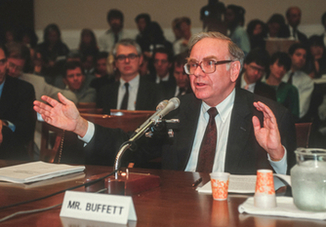It’s the most famous letter in the investing world.
Every year Berkshire Hathaway (NYSE: BRK-B) chairman and CEO Warren Buffett pens a letter to shareholders detailing what happened to the company and the stock the year before – as well as his outlook on what’s ahead.
(You can read the letter for every year going back to 1977 here.)
I highly recommend you read the latest 16-page missive – labeled 2023 – if you have 20 minutes to spare.
For those who aren’t used to his temperament, the 93-year-old Buffett comes off as a bit of a curmudgeon. But in reality, he’s just incredibly humble, honest and practical. And he has no time for investing foolishness or fads.
Buffett is the ultimate buy-and-hold investor. In this year’s letter, he says that he bought his first stock in March 1942 and has had most of his net worth in stocks since then. “And so far, so good,” he concludes.
He also throws water on those who would judge Berkshire by its annual net earnings loss or gain. This number was a positive $90 billion in 2021, a negative $23 billion in 2022 and a positive $96 billion in 2023.
But the number is “worse than useless,” Buffett writes, because it includes unrealized capital gains and losses. That is, it computes how Berkshire did based on year-by-year or even day-by-day movements in the stock market.
Berkshire’s vast portfolio holds stakes in some 50 companies, from Apple (Nasdaq: APPL) to Visa (NYSE: V), and of course the prices of those stocks fluctuate.
Buffett emphasizes that those short-term fluctuations don’t mean much because Berkshire is not buying and selling, or trading, but holding for the long term.
For example, one of Berkshire’s biggest holdings is Apple. It started buying the stock back in 2016, and it now owns about $164 billion worth of Apple shares, which accounts for about 44% of its equities portfolio.
Apple’s stock price has fluctuated since then, with some notable dips. That would have changed Berkshire’s net earnings a lot each year. But Buffett never sold.
And here’s how the stock has performed since he started buying it…
“It is more than silly, however, to make judgments about Berkshire’s investment value based on ‘earnings’ that incorporate the capricious day-by-day and, yes, even year-by-year movements of the stock market,” Buffett writes.
Instead of net earnings, Buffett would rather be judged by operating earnings, which exclude unrealized capital gains and losses. By that measure, Berkshire’s gains have improved steadily.
A Patriot
Every year’s letter to shareholders is different.
This year’s includes a moving tribute to his partner Charlie Munger, who died at age 99 last November. (Alexander Green wrote a great article about Munger in December, which is also worth reading.)
What also struck me in this year’s letter was Buffett’s love for his country. He talks about how America has been a great country for investors and how Berkshire’s allegiance will always be “to our country and our shareholders.”
Berkshire has invested in several companies that have also been enormous assets to our nation. Two that Buffett details are Occidental Petroleum (NYSE: OXY), which it owns about 28% of, and Burlington Northern Santa Fe Corporation (BNSF) – the largest rail system in North America – which it owns outright.
Occidental has helped the U.S. become energy independent in recent years, buffering it from geopolitical issues and the greed and whims of OPEC. And BNSF, along with other railroads, is vital to the country’s economic fortunes.
“A century from now, BNSF will continue to be a major asset of the country and of Berkshire,” Buffett writes. “You can count on that.”
Finally, Buffett describes the three executives who now steer the company and will take over when he leaves. Buffett picks managers as well as he does stocks, and he’s clearly leaving Berkshire and its shareholders in very good hands.
As ever, Berkshire Hathaway deserves a place in your portfolio.
And if you can’t afford the $617,300 price tag of a share of Class A stock, go for the Class B shares, which today sell for about $409. Both classes of shares are up about 33% over the last 52 weeks.
Credit: Source link













